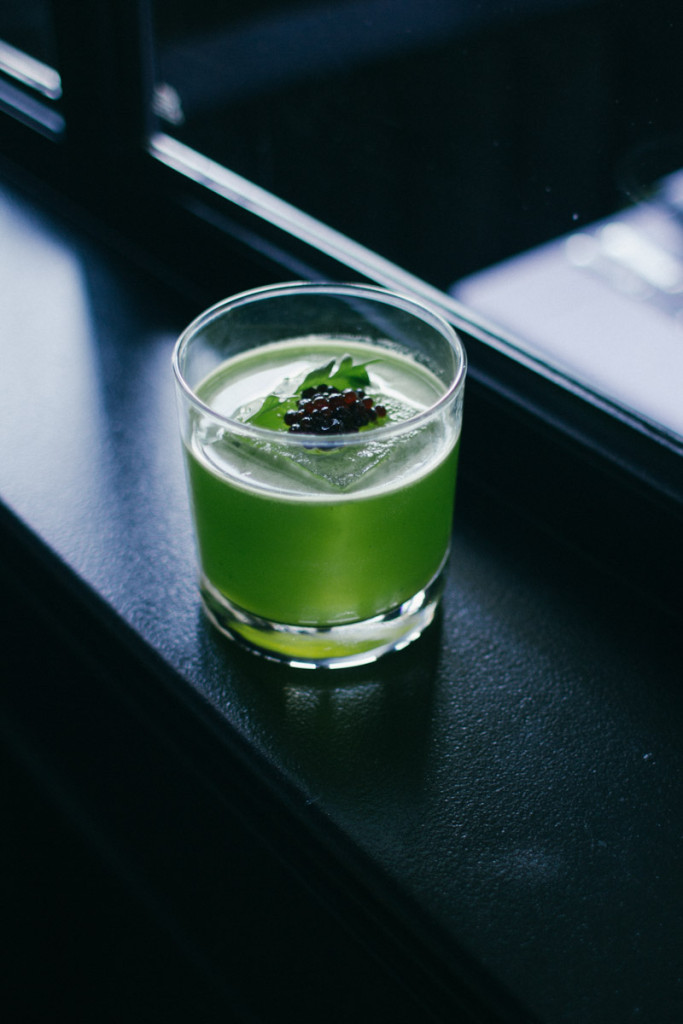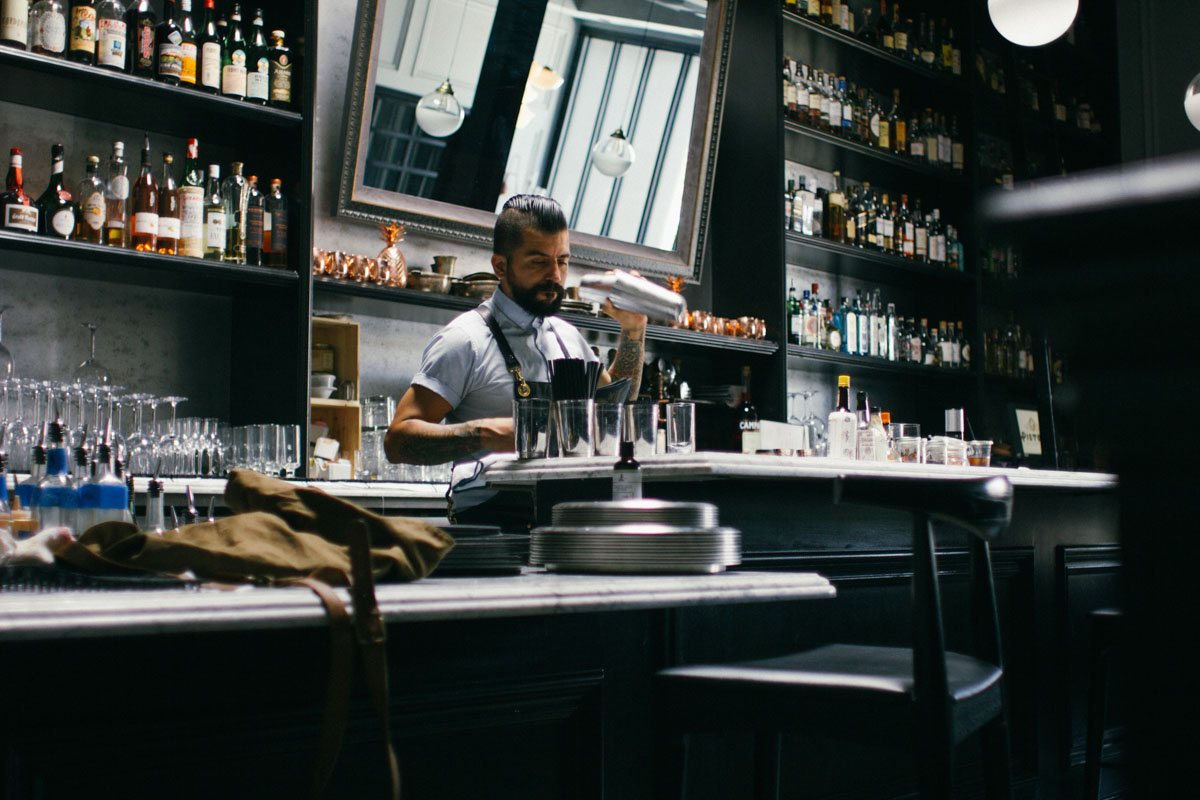“Stay with me now.” Aaron Melendrez tops off his jigger to two ounces with Aviation gin and throws it into a tin where I’ve just seen him muddle the hell out of a fistful of arugula. Arugula. I don’t say a word, but in the way that men often don’t need words, Melendrez can hear exactly what I’m saying: “That’s not a cocktail; it’s a salad for alcoholics.” Once the spirit has joined the mix though, a devilish grin spreads across his face, and he swirls together the unfinished mixture of pureed arugula, lime, simple syrup and a bitter French aperitif called Suze and holds it out toward me. And in a strange way, it works. The cocktail is focused with unquestioned clarity around the spring-influenced, citrus-leaning notes of the gin, and every other ingredient seems to extend it, to add dimension to it, like a well dug straight and deep.

Pistola’s Rocket Man
Healthy handful of arugula, muddle it in shaker tin with a capful of soda water and ½ oz. simple syrup. Muddle it thoroughly down to a paste or puree.
½ oz. – Suze
¾ oz. – lime juice
2 oz. Aviation Gin
Full tin of ice, long hard shake
Double rocks glass
Big ice cube, add a little salt on top of the ice cube
Add balsamic caviar on top
Melendrez has a rebellious streak in him, and in our conversation I often find his reason for doing things one way is simply that everyone else was doing it the other way. He turned heads earlier this year with a cocktail brazenly combining bone broth and an 18-year aged Glenlivet Scotch. And he’ll go to the hilt to defend that idea. “If you put a Bloody Mary in a bowl, is it not a cocktail now? Is it a gazpacho now? Because I don’t think it is—I think it’s still a cocktail. So if the only barrier between a cocktail and a soup is the vessel it’s in, let’s have some fun.”
That sentiment is so indicative of Melendrez’ approach to cocktails, and evidently it always has been. He made his first drink at the age of 13 with ingredients scrounged from around the house—a bit of vodka, a bottle of Cointreau with a rusty cap, the last few drops of cranberry juice in the fridge, and found out a decade later he’d essentially made a Cosmopolitan. It’s hard to picture a 13-year-old Aaron Melendrez without the tattoos, so I just go ahead and imagine him with the tattoos—spry and wiry and a bit awkward, but with two legit sleeves and that same brash determination in his face, to make a cocktail out of whatever was in that kitchen. He tells me he stared into that drink wondering what it was missing, before running back for lemon juice.
“A cocktail is a problem to be solved,” he explains, positioning a single cube of ice in a double rocks glass filled with hardy green juice. He opens a jar of little black droplets—balsamic vinaigrette formed into caviar. “The problem was, the droplets kept slipping off the edge of the ice. The solution: table salt,” says Melendrez. He sprinkles a pinch of salt onto the ice cube and follows with the balsamic droplets, and they adhere to it straightaway. It’s an odd drink, and yet oddly at home in a New American steakhouse like Pistola, where Chef Vic Casanova has made it a point to use every method at his disposal to wring harmony from a plethora of age-old Italian dishes—from generous helpings of truffle oil on the dry-aged steak tartare, to gold leaf on the risotto. There is a fascinating meeting of the minds here between Chef and Barman, both of whom are dedicated to breaking new ground while honoring the past of the American steakhouse.

The faithful of Pistola are a generation mostly between their mid-thirties and mid-fifties, who grew up eating at spots like Dan Tana’s or the Polo Lounge, places as awash in convention as they are in old Hollywood glamour and neon light. They’d go to the steakhouse to sip on healthy portions of manhattans and dirty martinis in an oversized glass and vodka Gibsons with one pickled onion to prime themselves for the healthy slab of porterhouse that would send them drearily off to bed. For years it was a ritual: dirty martini, steak, cherries jubilee; rinse and repeat. And yet, now, we find this young, tattooed bartender trying to reconcile the familiar aspects of the old steakhouse experience with the forward-thinking ways of the craft cocktail movement.
“Are you chintzing me?” Melendrez recalled being asked by a patron who didn’t understand his use of a jigger to measure drinks. Melendrez subsequently turned to free-pouring at the bar. He trains all his staff to free-pour, and drills them daily to see who can pour the most accurate three-quarter ounce, three-eighths of an ounce, all the tricky ones mind you. To the lady sitting in the bar stool a free pour looks more generous than a carefully measured drink. And Melendrez has taken this a step further, making the drink portions themselves more generous as well. His martinis go almost all the way up to the brim, earning him the ire of his servers, who hate to spill a drop of a good drink. “Nobody’s going to be upset about a little bit of liquid on the base of their glass. If anything, they’re happy they got that much in the drink,” he says.
Melendrez possesses an uncanny ability to bridge the gap between people and their drinks. And he does that by turning the classics a half step toward the tastes of his clientele. Take the negroni, for instance. A 1:1:1 ratio of gin, campari and sweet vermouth. And yet, for how celebrated and simple the negroni is, we should point out the steakhouse diner often finds it unpleasantly bitter. Melendrez gets around that by making Pistola’s house negroni with Gran Classico, another Italian bitter aperitif liquor with slightly less bitterness and slightly more sweetness, and by making the proportions of the drink more “spirit-forward”—so instead of 1:1:1, he allows gin to become the star of the drink, at a ratio of 1 ½ : ¾ : ¾.


“If you are a purist of the negroni, you want to shoot me right now,” Melendrez says. His voice becomes wooden: “‘You are a child messing with the classics—why don’t you just let the classics be classics?’” In response, Melendrez points back to the very recipes of the classic drinks themselves, which can be seen changing progressively in recipe books from the turn of the century to the Roaring Twenties to the days of prohibition and beyond. Indeed, just as the spirits available to us change improve or fade away, the recipes too remain transient, celebrated, riffed upon, all in equal measure and equal love. “Nothing is the same anymore. Not even at the Savoy,” he says. Melendrez is referring to The Savoy Cocktail Book, published in 1930 by Harry Craddock at the Savoy in London—quite possibly the most influential book of drink recipes in history.
The cocktail menu at Pistola cascades downward from the most ubiquitous steakhouse drinks to Melendrez’ own most adventurous concoctions, so that the first item is also the most recognizable: the dirty martini. He places these standards in the Timeless section of his menu, and follows it with an Experimental section, another for Restorative, and yet another for Revitalizing drinks. There is a Mai Tai for which Melendrez cooks up a house-made orgeat of fire-roasted walnuts and sunflower, there is the Young Turk, a riff on the Moscow mule that imparts a chamomile-infused Patron Silver Tequila to a fresh, intense ginger syrup, and then there is the Rocket Man, Melendrez’ famous green drink of gin and pureed rocket arugula topped with beads of balsamic caviar. Each drink bears his fingerprints, whether in the choice of the spirit’s brand or the method of extracting juices (Melendrez is partial to cold-press juicing so as not to cook out essential nutrients and flavor).

More than once during my visit I see Melendrez dart up the sliding ladder to grab bottles high on the back bar. This place is his playground. He is a 1:1:1 ratio of chemist, architect and entertainer, just as gleeful to collaborate with the chef to create new drinks (I’m told it was Chef Vic who came up with the consommé of lamb for Melendrez’ bold bone broth drink, and such collaborations with the kitchen don’t end there; he also works with the pastry chef and many others) as he is to practice the unpredictable art of hospitality, serving thirsty patrons who can be all at once frustrating, illuminating, indecisive, and in the end, grateful.
“I’m a fucking bartender. I’m here to make drinks that make people happy.”
—
Pistola
8022 W 3rd St, Los Angeles, CA 90048







Our comments section is for members only.
Join today to gain exclusive access.